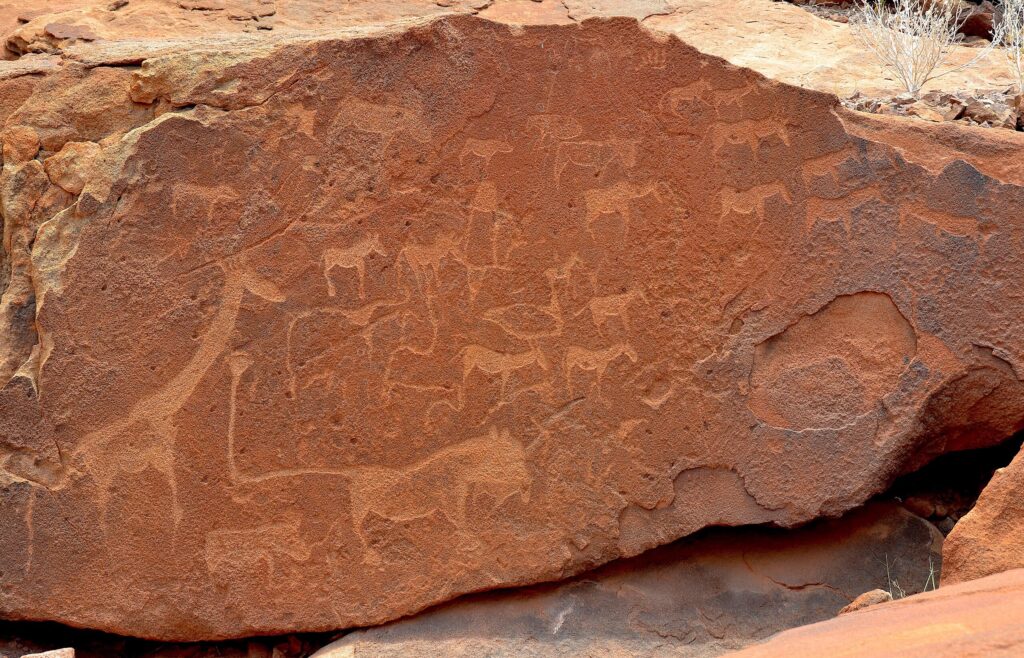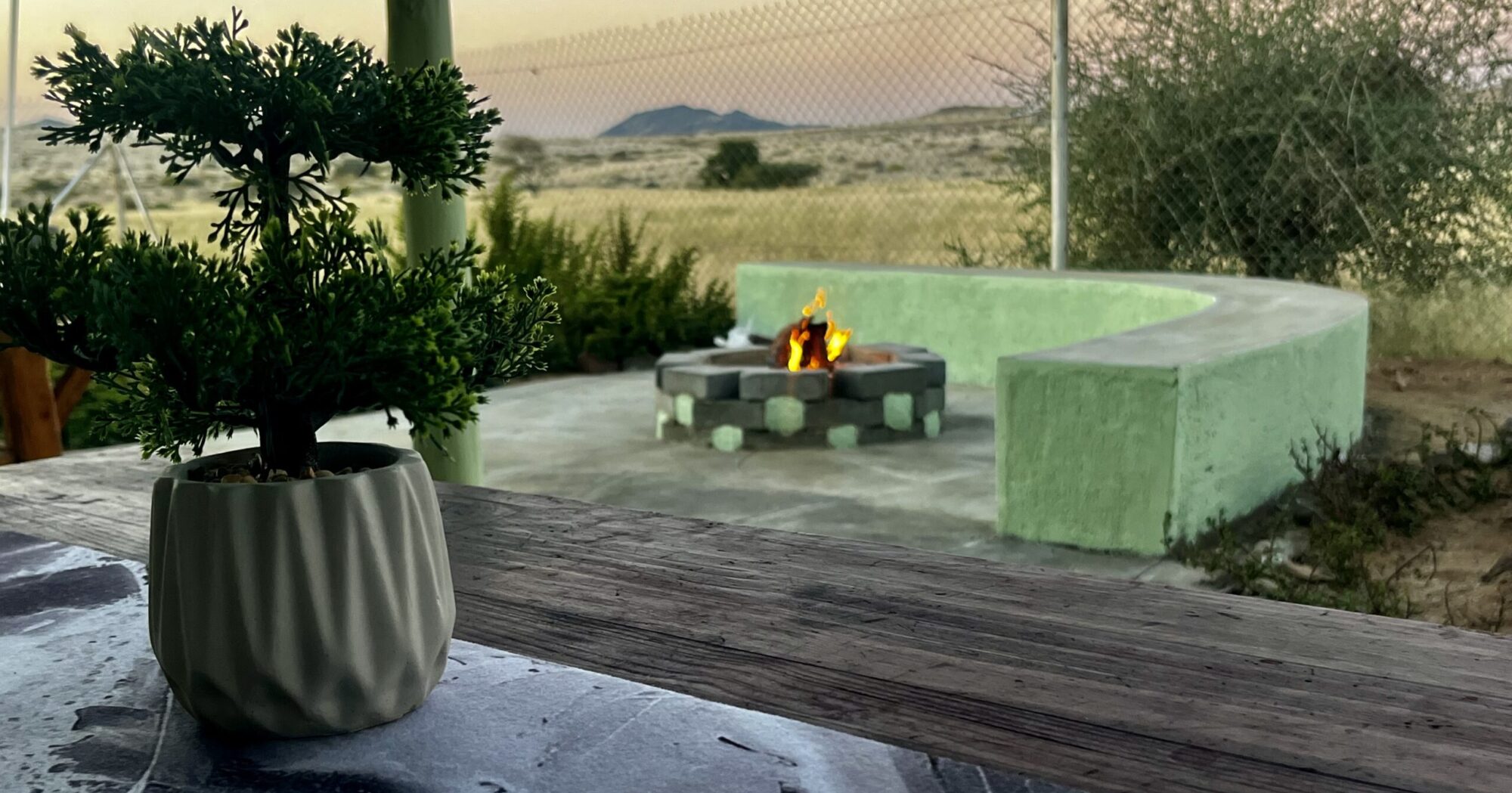Discover the Mysteries and Wonders of Uis & the Brandberg

Uis is more than just a quiet mining town—it’s a gateway to some of Namibia’s most fascinating history, art, and geology. From ancient rock paintings to modern lithium discoveries, Uis and the surrounding Brandberg region hold stories that span thousands of years. Elephants roam less than 40 km away in the wild, and the sunsets are unforgettable.
The Brandberg – Namibia’s Highest Mountain

The Brandberg, meaning “Burning Mountain” in German, dominates the horizon near Uis. Rising to 2,573 meters (8,439 feet) at Königstein Peak, it is Namibia’s highest point. Its name comes from the red glow at sunset—a breathtaking view.
- Formed from ancient volcanic granite.
- Home to over 50,000 San rock paintings.
- Habitat for desert elephants, leopards, and rare flora.
- A UNESCO-listed cultural heritage site.
The White Lady – Namibia’s Most Famous Rock Painting

Hidden deep in the Tsisab Ravine, the “White Lady” is a world-renowned San rock painting. Despite the name, the central figure is a male shaman or hunter in ritual motion.
- Over 2,000 years old, painted in ochre and charcoal.
- Misidentified in 1918 by Henri Breuil as a Mediterranean figure.
- Shows symbolic figures, animals, and ritual scenes.
- Accessible only via guided hike through the Brandberg.
History of the White Lady
Discovered during a 1917 German expedition, the painting captured early European imaginations. Henri Breuil popularised the name “White Lady” in 1929, believing it had Phoenician or Mediterranean connections.
Later scholarship recognised these interpretations as colonial myths. Today, the painting is rightly credited to the indigenous San people and respected for its African heritage.
Description of the White Lady Painting
The “White Lady” likely portrays a ritual or trance ceremony. The central figure carries a bow and vessel and is painted with light limbs, possibly symbolising body paint.
Nearby figures are simplified. One oryx has human legs—adding a spiritual meaning. Paints were made from ochre, charcoal, hematite, and organic binders.
The artwork has suffered from early visitor damage. Today, it is protected, with mesh barriers replaced by improved viewing infrastructure. No personal items are allowed near the rock face.
The 26 Unmarked Graves – A Forgotten History

Near Uis lie 26 unmarked graves from the early 1900s. Possibly tied to German colonial tin mining, the site remains unexplained.
- Identities unknown—could be miners, workers, or victims.
- Likely linked to poor working conditions or disease.
- Undocumented and untouched to this day.
The Uis Tin Mine – Once Among the World’s Largest

Tin mining defined Uis. The Uis Tin Mine operated until 1990 and was once a world-leading source of high-quality tin.
- 1911 – Tin discovered by Germans.
- 1958 – Imkor Tin starts large-scale mining.
- 1970s–80s – Peak production era.
- 1990 – Closure due to falling tin prices.
- 2015+ – Uis Tin Mining Company revives operations.
- New lithium discoveries spark further interest.
The Lithium Boom – A Modern Gold Rush

Lithium is now transforming Uis again. With global demand for electric vehicle batteries, mining has returned in full force.
- Vital mineral for renewable energy and EV batteries.
- Extracted alongside tin by companies like Andrada Mining.
- Revival brings jobs and development.
- Environmental concerns remain—especially water use.
Art in Uis – Sculptures by Coenraad Louw
Local artist Coenraad Louw has created metal sculptures that celebrate Uis’ culture and wildlife.
The Elephant in Uis

- Life-size metal sculpture honours the desert elephants near Uis.
- Symbol of strength, survival, and community spirit.
- A favourite spot for travellers and photographers.
The White Lady Statue

- A sculptural tribute to the famous White Lady rock painting, recreated in striking three-dimensional form.
- Honours San heritage and the cultural significance of the Brandberg rock art.
- Located in Uis for easy access to those unable to hike to the original site.
Discover Uis — A Town of Hidden Treasures
From the mystery of ancient graves to the legendary White Lady and the rise of lithium mining, Uis offers stories etched in stone and written in the stars.
The Petroglyphs of Twyfelfontein

The Lion Plate at Twyfelfontein — Photo by Olga Ernst
Twyfelfontein, a UNESCO World Heritage Site in northwestern Namibia, is one of the richest rock art galleries in Africa. Its ancient engravings and paintings date back as far as 10,000 years.
First inhabited by Wilton hunter-gatherers, followed by the Khoikhoi, the site reflects thousands of years of symbolic and spiritual expression. Known to the Damara people as ǀUi-ǁAis (“jumping waterhole”), it remains a sacred place.
Artists etched images into the dark “desert varnish” of sandstone using stone tools, revealing the lighter rock beneath. Their work remains vivid, preserved by arid conditions and the unique geology of the area.
Engravings fall into three main categories:
- Iconic: Animals, people, and mystical beings.
- Abstract: Symbols, dots, and geometric patterns.
- Functional: Grinding hollows and resonant stones.
Rare rock paintings, especially in red ochre, also appear in sheltered locations. These multi-medium artworks make Twyfelfontein uniquely rich in archaeological value.
Spitzkoppe — The Matterhorn of Namibia
Rising sharply from the desert, Spitzkoppe’s granite peaks are among Namibia’s most iconic sights. Just 250 km from Windhoek, the main peak reaches 1,728 metres and is surrounded by dramatic rock formations and natural arches.
Formed over 120 million years ago, this geological wonder glows in gold and crimson hues at dawn and dusk. The smooth granite is perfect for climbers, photographers, and nature lovers alike.
Spitzkoppe offers over 200 climbing routes, hidden canyons for hiking, and ancient San rock art. Bushman’s Paradise, once a vibrant rock art gallery, is still accessible and worth the climb.
At night, Spitzkoppe becomes a celestial stage. With zero light pollution, the Milky Way becomes a living tapestry — perfect for stargazing and astrophotography.
Camping here is managed by the local Damara community. Sites are private, nestled among boulders, and offer basic amenities. Community-led tourism ensures that your visit benefits the people of the region directly.
Easily accessible by road, visitors should bring essentials, as shops are few and far between. Spitzkoppe is a journey through time — geological, cultural, and cosmic.
Plan Your Stay in Uis
Stay at Green Elephant Cottages — your gateway to ancient wonders, desert stars, and unforgettable Namibian adventures.
Contact Penny for info on Sunset Tours and Elephant Tours.


